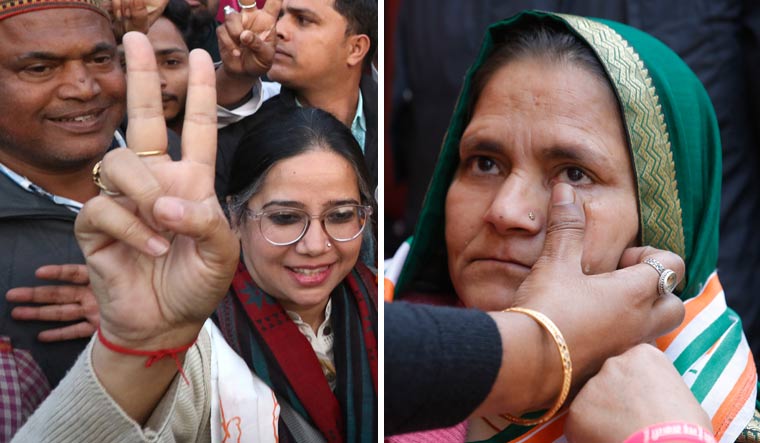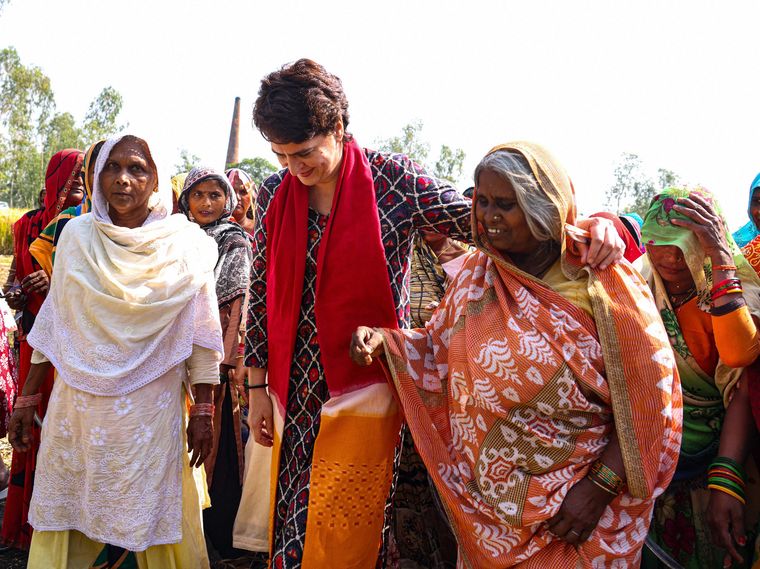IT IS AROUND NOON. Asha Singh, 55, is getting ready to hit the campaign trail. Her daughters preen her and give her some last-minute advice as she steps out of her rented home in Unnao, Uttar Pradesh. The pallu of her sari covers her head, a Congress scarf sits on her shoulders. She says little, but is clear about why she is contesting. Her fight, she says, is for justice.
In 2017, Singh’s daughter was raped. The crime raised nationwide furore and, two years later, then BJP MLA Kuldeep Singh Sengar was given the life sentence. However, Singh’s family has lost much. In 2018, her husband was allegedly beaten to death in police custody. Her daughter spent a year in hospital after a road accident in 2019. The family alleged that Sengar had a hand in the incident, but a Delhi court discharged him for want of evidence. Singh’s brother-in-law was sent to jail for attempt to murder in a 19-year-old case in 2019; the family claims he was framed.
“I had to flee my village to protect us from Sengar’s goons,” she said. “The only way I can secure justice for my family is by joining politics.”
Singh is contesting from the Unnao Sadar constituency—a two-hour drive from Lucknow. She now lives in Delhi with her four daughters and son, and only recently returned to Unnao. The response there, though, has been lukewarm. Not only is her traditionally patriarchal Thakur community displeased with her boldness, but many in the region also see Sengar as a victim.
Singh, however, is undeterred.
As is Sadaf Jafar, the Congress candidate in Lucknow Central. She is a teacher, activist and actor last seen in Mira Nair’s adaptation of A Suitable Boy. Jafar first hit the headlines during an anti-Citizenship (Amendment) Act stir in December 2019; she was the only woman arrested in the Lucknow protest. “Lucknow Central has seen me struggle even before that. The Yogi government had detained me earlier as well,” said Jafar, who has taught in some of Lucknow’s prominent schools.
She joined the Congress as she felt that only politics could bring the change she wanted to make through activism. A single mother to a daughter, 18, and a son, 14, she has taken life’s struggles in her stride.
Both Singh and Jafar are part of Priyanka Gandhi Vadra’s women-centric election campaign in Uttar Pradesh. The Congress general secretary had, in October, announced that 40 per cent of her party’s candidates for the state elections would be women. Others in the fray include an ASHA (Accredited Social Health Activist) worker who was allegedly beaten up for asking for better wages, a national-level shooter who protested the farm laws, and a grassroots politician whom BJP workers allegedly manhandled during last year’s panchayat polls.
Though the Congress is not expected to win big, its ‘Ladki Hoon, Lad Sakti Hoon’ campaign has grabbed headlines. It has promised women 40 per cent reservation in jobs, 25 per cent in police posts, 50 per cent in public distribution system shops, and free e-scooters, smartphones and bus rides.
The Congress’s gender gambit is seen as a desperate move to carve out a new constituency; the party has no support base in the state. In its heyday, it had the support of a wide range of voters, including Brahmins, dalits, tribals and minorities. Since the 1980s, though, many of them have deserted it. In the 2017 state elections, the party had got just seven seats and 6.25 per cent votes. Several of its leaders have since left for greener pastures.
This wooing of women, said party leaders, would set new standards for political parties. “Other parties have been forced to talk about women’s issues,” said Pankaj Srivastava, vice chairman of the state Congress’s media department. “This can be the basis of secular politics as women from every section of society are looking for political empowerment.”
Of the 15 crore voters in Uttar Pradesh, 6.98 crore are women. Compared with the 2017 elections, the number of woman voters has gone up by 52 lakh. In 2012, for the first time, more women voted than men. This trend has since continued.
Women are said to have played an important role in the Samajwadi Party’s win in 2012. In 2017, the BJP benefited from the Pradhan Mantri Awas Yojana (housing scheme) and free gas connections under the Ujjwala Yojana. The triple talaq law even got it some Muslim votes.
The BJP believes that women are its silent voters. At a public meeting in December, which reportedly 2.5 lakh women attended, Prime Minister Narendra Modi made several announcements—this included transfer of Rs20 crore into the accounts of 1.01 lakh girls, putting Rs1,000 crore into the accounts of self-help groups and increasing the age of marriage from 18 to 21.
Also read
- 'BJP scores big': Election results so far in Goa, Punjab, UP and Uttarakhand
- UP polls: Akhilesh Yadav's solo fight to recapture Lucknow
- Akhilesh Yadav interview: I have learnt how to defeat the BJP
- Dalit identity has become more assertive, but Mayawati has moved at a snail's pace
- Manifestos are fake; we do what we say: BSP’s Satish Chandra Misra
- No samajwad in Samajwadi Party: Aparna Yadav, BJP
“Priyanka Gandhi’s announcements are election gimmicks,” said Rita Shastri, vice president of the state’s BJP Mahila Morcha. “The BJP, on the other hand, has worked consistently to empower women. Law and order has been established and women can go out without any fear.”
The Samajwadi Party is also trying to shed its “misogynistic” image. Party president Akhilesh Yadav has alleged that women’s security has suffered under Adityanath. The party has promised enhanced financial assistance to women and has proposed a scheme to help sportswomen.
“Women play an important role in the victory of any party,” said Juhie Singh, head of the Samajwadi Party’s women’s wing. “While it is believed that women are guided by their families’ choices, they are increasingly voting on the basis of who will give them economic security or better education and health care.”
However, despite all the pro-women pledges, their share in power remains miniscule. In 2017, when the BJP won, it had its largest ever tally of women MLAs at 34. But this was just 11 per cent of its total MLAs.
Said Professor Roop Rekha Verma, founder secretary of the NGO Saajhi Duniya: “It will be wrong to believe that women are a different constituency or that, all of a sudden, they are occupying more space in democracy. Yes, the percentage of women voters has increased and their voting percentage has gone up. That could have to do with the Election Commission’s awareness campaign and greater voter enrolment.”
However, on the ground, women do seem to be realising their potential electoral might. Rani Devi, a 30-year-old from Dostinagar village in Unnao Sadar, said that though the Ujjwala scheme helped her, the government needed to do more. Her husband Baldeo, a farmer, said cash transfers would make people lazy, but she disagreed. “We should have money of our own, especially in times of difficulty,” she said.
The woman voter of Uttar Pradesh, it seems, will no longer be ignored.



